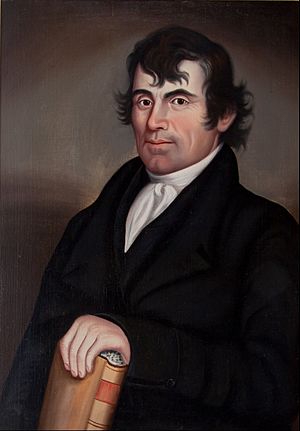Benjamin Logan facts for kids
Quick facts for kids
Benjamin Logan
|
|
|---|---|
 |
|
| Member of the Kentucky House of Representatives from Shelby County |
|
| In office 1792–1795 |
|
| Member of the Virginia House of Delegates from Lincoln County |
|
| In office October 17, 1785 – October 14, 1787 Serving with John Edwards, John Jouett
|
|
| Preceded by | John Logan |
| Succeeded by | Baker Ewing |
| In office May 7, 1781 – April 1782 Serving with John Edwards
|
|
| Preceded by | position created |
| Succeeded by | Isaac Hite |
| Personal details | |
| Born | May 1, 1743 Augusta County, Colony of Virginia |
| Died | December 11, 1802 (aged 59) Shelbyville, Kentucky |
| Military service | |
| Branch/service | Virginia Militia Kentucky Militia |
| Years of service | 1764-1788 |
| Rank | General |
| Battles/wars | |
Benjamin Logan (born May 1, 1743 – died December 11, 1802) was an important American pioneer, soldier, and politician. He played a big part in the early history of Kentucky. As a colonel in the Virginia militia during the American Revolutionary War, he was a top leader in the western part of Virginia.
Later, he became a politician and helped Kentucky become its own state. His brother, John Logan, also served in the militia and became Kentucky's first state treasurer.
Contents
Early Life and Family
Benjamin Logan was born in Augusta County, Virginia. He was the oldest son of Scottish immigrants, David and Jane Logan. When Benjamin was 15, his father died. He later sold his family's farm and shared the money with his siblings. He then moved across the Appalachian Mountains to the Holston River, where he started his own farm.
In 1772, Benjamin Logan married Ann Montgomery. They had eight children together.
A Brave Soldier and Leader
Benjamin Logan served in the Virginia militia, which was like a local army. He fought in a campaign against the Shawnee people in 1764. Ten years later, he was a lieutenant in Lord Dunmore's War against the same group.
In 1775, Logan joined a group of settlers, including Daniel Boone, who traveled to Kentucky. At that time, Kentucky was the western edge of Virginia. Logan settled in what is now Lincoln County, Kentucky. With help from his brother John and others, he built a fort called Logan's Fort. This fort later grew into the town of St. Asaph's, near Stanford.
In 1776, Logan brought his family to Kentucky. They first stayed at Harrod's Fort, which was safer from attacks. But in 1777, they moved to Logan's Fort.
Defending Logan's Fort
On May 20, 1777, about a hundred Native American warriors surrounded Logan's Fort. The people inside the fort started to run out of food and ammunition. Benjamin Logan and two friends bravely left the fort at night. They traveled 150 miles to the Holston settlement to get help.
Logan quickly returned with gunpowder and lead. His friends followed with a rescue group led by Colonel John Bowman. When the attackers saw the relief party, they scattered, and the siege ended.
Military Campaigns
Logan became a sheriff and a justice of the peace in the county. During the American Revolution, he was the second-highest officer in the Virginia militia for Kentucky. He helped defend the settlements from attacks by Native American groups, who were sometimes supported by the British.
In July 1779, Logan led 300 men on an expedition across the Ohio River to a Native American village called Chillicothe. He also joined campaigns against groups north of the Ohio River, serving under George Rogers Clark. However, Logan and Clark often disagreed on how to fight.
Logan's Raid
In October 1786, Logan led a group of Kentucky militiamen against Shawnee towns in the Ohio Country. This event is known as Logan's raid. Many warriors were away defending other villages, so these towns were not well protected.
Logan's men seized and burned thirteen villages. They captured women and children and destroyed food supplies. During this raid, an elderly chief named Moluntha surrendered under a U.S. flag. Sadly, despite efforts to protect him, Captain Hugh McGary killed Chief Moluntha. This act made the Shawnee very angry, and they increased their attacks against settlers, leading to more conflict in the Northwest Indian War.
A Leader in Politics
After America became independent, Benjamin Logan worked hard to make Kentucky a separate state. He served as Kentucky's representative in the Virginia House of Delegates from 1781 to 1787. During this time, he began to argue for Kentucky to become its own state.
Benjamin Logan was a strong supporter of Kentucky statehood at the Danville Convention. He was also a delegate when Kentucky wrote its first constitution in 1791 and 1792. After Kentucky became a state, he served in the Kentucky House of Representatives from 1792 to 1795. He ran for governor in 1796 and 1800 but did not win.
Death and Legacy
Benjamin Logan passed away from a stroke on December 11, 1802, at the age of 60. He died at his home near Shelbyville, Kentucky and was buried in his family's cemetery.
Both Logan County, Kentucky and Logan County, Ohio are named after him. The Benjamin Logan Local School District in Ohio also carries his name.
He was the uncle of U.S. Supreme Court associate justice John McKinley.

